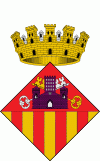Sant Cugat del Vallès (Sant Cugat del Vallès)
 |
In addition to the monastery, the town's other notable buildings include the School of Architecture of the Vallès and the Centre d'Alt Rendiment (CAR, translit. High Performance Centre), a famous centre for professional sport training.
Sant Cugat has become an affluent suburb of Barcelona due to its location (only 20 kilometres from the city), its natural surroundings, and its pedestrian shopping area. Sant Cugat also offers restaurants, a concert venue, two cinemas, and one large shopping centre. It is also a political stronghold for conservative Catalan nationalism, with Convergència i Unió dominating the town's politics for 32 years up until 2019 when Esquerra Republicana de Catalunya took control of the City Council with the support of other political forces (PSC and CUP).
Sant Cugat has seen its population increase in recent years, with more births than bigger cities like Barcelona (2004). It has also practically merged with the nearby Rubí (population 72,987) and Cerdanyola del Vallès (population 58,747).
The town has its own train station with a direct metro connection into Barcelona city centre and the nearby industrial cities of Terrassa and Sabadell.
Map - Sant Cugat del Vallès (Sant Cugat del Vallès)
Map
Country - Spain
 |
 |
| Flag of Spain | |
Anatomically modern humans first arrived in the Iberian Peninsula around 42,000 years ago. The ancient Iberian and Celtic tribes, along with other pre-Roman peoples, dwelled the territory maintaining contacts with foreign Mediterranean cultures. The Roman conquest and colonization of the peninsula (Hispania) ensued, bringing the Romanization of the population. Receding of Western Roman imperial authority ushered in the migration of different non-Roman peoples from Central and Northern Europe with the Visigoths as the dominant power in the peninsula by the fifth century. In the early eighth century, most of the peninsula was conquered by the Umayyad Caliphate, and during early Islamic rule, Al-Andalus became a dominant peninsular power centered in Córdoba. Several Christian kingdoms emerged in Northern Iberia, chief among them León, Castile, Aragon, Portugal, and Navarre made an intermittent southward military expansion, known as Reconquista, repelling the Islamic rule in Iberia, which culminated with the Christian seizure of the Emirate of Granada in 1492. Jews and Muslims were forced to choose between conversion to Catholicism or expulsion, and eventually the converts were expelled through different royal decrees.
Currency / Language
| ISO | Currency | Symbol | Significant figures |
|---|---|---|---|
| EUR | Euro | € | 2 |
| ISO | Language |
|---|---|
| EU | Basque language |
| CA | Catalan language |
| GL | Galician language |
| OC | Occitan language |
| ES | Spanish language |















